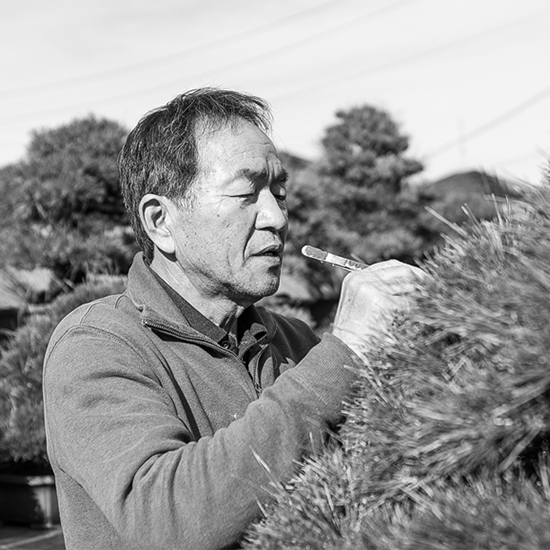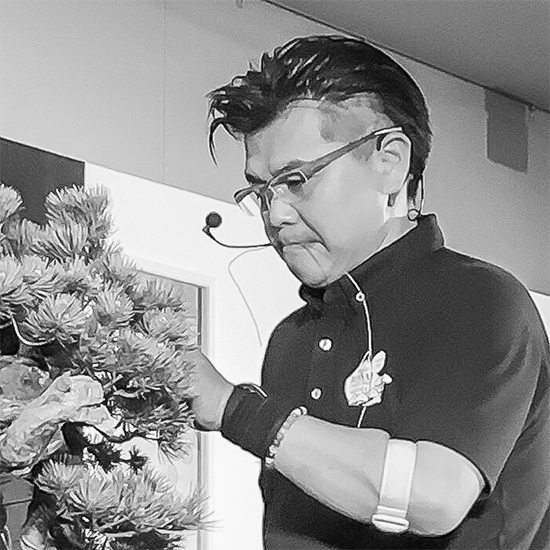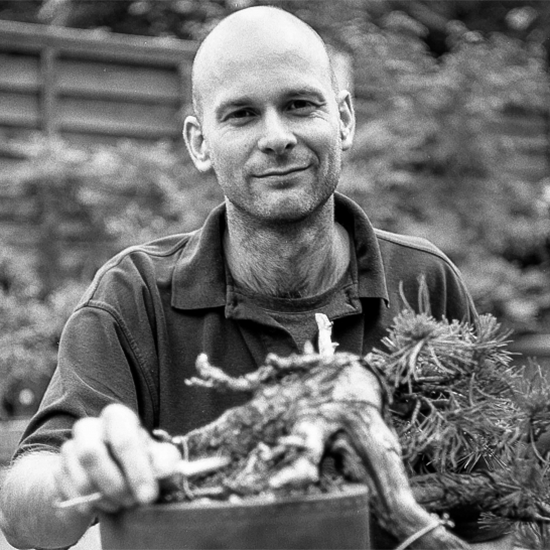Bonsai Master's voice
“TOKONAME” is an important partner of bonsai making from the daily care to the exhibition
The first generation of the “BONSAI DAIJUEN” founded in 1935 has a career that has brought the “KOWATARI” to the Tokoname maker and was devoted to making pots in “TOKONAME”.
Selection of pots tends to focus on thinking about the shape, tone and texture of pots that attract the most beautiful tree shapes, but in the bonsai world where the longevity is respected. We believe it is very important that you have steady features to protect.
Because “TOKONAME” uses clay produced in the same area where we have bonsai gardens, There is a reliable sense of security that we provide the optimum environment for protecting the trees we grow. I realize that every day I feel that I can stabilize the roots of trees and focus on bonsai creation.
Also when pots are displayed at exhibitions they reflect the preferences of each bonsai maker. However when preparing for exhibitions it is very important to use pots that correspond to bonsai that will eventually be created and Tokoname bonsai pots, through daily use, care and interaction, will help the bonsai makers imagination that I feel is a dependable partnership.

TORU SUZUKI
◎ Third head of BONSAI DAIJUEN
◎ Mr.Saichi Created a “Tanyoho” of Kuromatsu Bonsai, driving force of Kuromatsu Bonsai
◎ Mr.Suzuki 3rd generation is vice chairman of Nippon Bonsai Growers Cooperative, chairperson of Nippon Bonsai Taikaiten
The skill of a craftsman who does not cause any distortion causing water to pool in a pot, that is “TOKONAME”
Mr. Fujikawa who trained under Mr. Masahiko Kimura, a master of contemporary bonsai from the age of 20. While creating a work that makes you feel delicate and beautiful in dynamic nature and in a tree shape Approximately 100 years old pot of Antique Chinese Pots with shallow depth is his favorite.
In daily bonsai creation also “TOKONAME” is highly usable.
I think “TOKONAME” seems to be strongly faced with trees everyday as being a pots designed primarily considering the growth of trees. Because “TOKONEME” is difficult for the pots to crack due to absorption of water.
In addition, the flat bottom with no distortion produced by the craftsmanship of “TOKONAME” is one of the very important elements to protect and nurture trees and also with hundreds of years of history it can be said that it is a pots that can be used with peace of mind.

Masayuki Fujikawa
◎ The representative of FUJIKAWA HOSEI EN
◎ Won the Prime Minister’s Award of the 43rd Nippon Bonsai Sakufuten (2017)
◎ Trophy official demonstrators (2019)
Wonderful skills and techniques for creating pots that do not exist outside of Tokoname
The pursuit of excellence for a craftsman is based on a foundation of knowledge and skills which have been developed over successive generations. This is true for the creation of bonsai containers as much as it is for the bonsai themselves, and those pots created in Tokoname have a long history and are recognised the world over the standard of excellence. Ceramic production in the Tokoname area dates back to the 12th Century and it is on this foundation and tradition that bonsai pots were first created on an industrial scale over a hundred years ago.
Designing bonsai ceramics has always been a process of working with professional bonsai growers to develop usable styles, shapes and sizes that work from an aesthetic perspective and allow the trees to grow in a healthy way. The proximity of Tokoname to the large bonsai community in Aichi prefecture has allowed such collaboration to occur, resulting in a wide range of pots which have come to define the look and style of Japanese bonsai for enthusiasts around the world.
Over the last ten years the appreciation of ceramics in the West has become an important part of the pursuit of bonsai, and for those who look to pursue the Japanese aesthetic, the gold standard is Tokoname. The current generation of potters are revered as master craftsmen and their finest works are sought after as the level of bonsai practice throughout the world increases. This is due to the usability, classical design and build quality of Tokoname pots.
The attention to detail and clay quality is unsurpassed in modern bonsai ceramic production throughout the world, creating pots that are both incredibly light and thin, yet strong and frost resistant. Many of the more difficult to create shapes and sizes such as very large and shallow ovals can only be found in Tokoname, as can the consistency of colour and texture for both glazed and unglazed pots. These are skills and techniques that do not exist outside of Tokoname, making it rightfully the recognised home and centre of excellence for Japanese bonsai ceramic production.

Peter Warren
Peter Warren is a London based British bonsai professional who undertook a traditional six year apprenticeship under the world famous master Mr. Kunio Kobayashi at his nursery in Tokyo, Shunkaen Bonsai Museum. After graduating in 2009 Mr. Warren has been teaching and working with enthusiasts around the world and establishing his own nursery on the outskirts of London.
